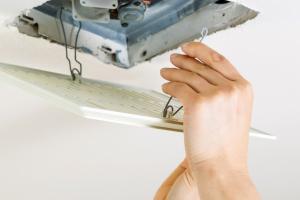Ultimate Guide on How to Clean a Bathroom Fan: Step-by-Step for a Fresh Home

-
Quick Links:
- Introduction
- Importance of Cleaning Bathroom Fans
- Tools and Materials Needed
- Step-by-Step Guide to Cleaning a Bathroom Fan
- Safety Tips
- Common Mistakes to Avoid
- Expert Insights
- Case Studies
- FAQs
Introduction
Bathroom fans are an essential part of maintaining air quality and preventing moisture buildup in your home. However, they often go unnoticed until they start making noise or functioning poorly. Regular cleaning is crucial to ensure they operate efficiently. This guide will provide you with a comprehensive, step-by-step process for cleaning your bathroom fan effectively.
Importance of Cleaning Bathroom Fans
Cleaning your bathroom fan is not just about aesthetics; it plays a vital role in:
- Preventing Mold Growth: Accumulated dust and moisture can lead to mold, which poses health risks.
- Improving Air Quality: A clean fan helps circulate and maintain fresh air in your bathroom.
- Extending Fan Lifespan: Regular maintenance can prolong the life of your fan and reduce the need for replacements.
- Enhancing Energy Efficiency: A clean fan operates more efficiently, saving you money on energy bills.
Tools and Materials Needed
Before you start cleaning, gather the following tools and materials:
- Step ladder
- Screwdriver (flathead and Phillips)
- Vacuum cleaner with a brush attachment
- Microfiber cloths
- Warm soapy water
- Brush or old toothbrush
- Disinfectant spray
- Safety goggles and mask (for dust protection)
Step-by-Step Guide to Cleaning a Bathroom Fan
Step 1: Turn Off Power
Safety first! Before you do anything, turn off the power to the bathroom fan at the circuit breaker to avoid any accidents.
Step 2: Remove the Cover
Using your screwdriver, carefully remove the fan cover. Most covers will either snap off or have screws holding them in place. Be gentle to avoid damaging the cover.
Step 3: Clean the Cover
Soak the cover in warm soapy water for about 10 minutes. Use the brush or toothbrush to scrub away any grime or mold. Rinse and let it dry completely.
Step 4: Vacuum the Fan Blades
Using the vacuum cleaner with a brush attachment, carefully clean the fan blades. This will remove dust and debris that have accumulated over time.
Step 5: Wipe Down the Fan Housing
Using a microfiber cloth and disinfectant spray, wipe down the fan housing to remove any remaining dust and dirt.
Step 6: Reattach the Cover
Once everything is dry, reattach the fan cover securely. Ensure that it fits properly and that all screws are tightened.
Step 7: Turn Power Back On
Finally, turn the power back on at the circuit breaker and test the fan to ensure it’s working correctly.
Safety Tips
- Always ensure the power is off before starting any cleaning tasks.
- Use a sturdy ladder to reach high fans safely.
- Wear safety goggles and a mask to protect against dust and debris.
Common Mistakes to Avoid
When cleaning your bathroom fan, keep these common pitfalls in mind:
- Not turning off power before cleaning.
- Using excessive water, which can damage electrical components.
- Neglecting the fan motor and housing during cleaning.
Expert Insights
According to home maintenance experts, neglecting your bathroom fan can lead to a host of problems, including increased humidity levels that promote mold growth. Regular maintenance is essential for keeping your home healthy and safe.
Case Studies
Consider the case of a homeowner in Seattle, who neglected their bathroom fan for years. After cleaning it for the first time, they noticed a significant reduction in bathroom moisture levels and improved air quality. The fan functioned quieter and more efficiently, leading to lower energy bills.
FAQs
1. How often should I clean my bathroom fan?
It’s recommended to clean your bathroom fan every 6 to 12 months, depending on usage.
2. Can I use water to clean the fan motor?
No, avoid using water on the fan motor. Instead, use a dry cloth or vacuum to clean it.
3. What should I do if my fan is making noise?
A noisy fan may need lubrication or may have loose parts. Cleaning it might help, but further inspection may be necessary.
4. Is it necessary to hire a professional for cleaning?
While DIY cleaning is effective, hiring a professional can be beneficial for deep cleaning and maintenance.
5. What if my fan has mold?
If mold is present, use a mixture of vinegar and water to clean it. If the problem persists, consider replacing the fan.
6. Can I clean my fan while it’s still mounted?
It’s best to remove the fan cover for thorough cleaning, but you can wipe the exterior while it’s mounted.
7. Are there special cleaning products for bathroom fans?
No specific products are required; warm soapy water and disinfectants are sufficient.
8. Do bathroom fans have filters that need changing?
Most bathroom fans do not have filters, but check your model's specifications.
9. Can I use a vacuum cleaner to clean the fan?
Yes, using a vacuum cleaner with a brush attachment is an effective way to remove dust from the fan blades.
10. What are the signs that my bathroom fan needs cleaning?
Signs include visible dust accumulation, reduced airflow, and increased noise levels.
Random Reads
- How to update your routers firmware
- How to add someone as a friend on roblox
- Simple solutions for repairing plastic holes
- How to recolor anything on gimp
- How to receive gift on xbox one
- How to install molding
- How to install mods in euro truck simulator
- How to delete file access denied error
- How to delete ebay account
- Easy ways to program rca universal remote